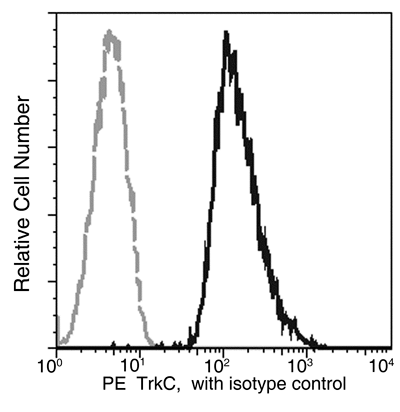-
Product Name
Anti-TrkC/NTRK3 antibody
- Documents
-
Description
Mouse monoclonal to TrkC/NTRK3
-
Tested applications
FCM
-
Species reactivity
Human TrkC / NTRK3
-
Alternative names
TRKC antibody; NT-3 growth factor receptor antibody; hCG_26627 antibody; Neurotrophic tyrosine kinase, receptor, type 3 antibody; Tyrosine-protein kinase receptor antibody
- Immunogen
-
Isotype
Mouse IgG1
-
Preparation
This antibody was produced from a hybridoma resulting from the fusion of a mouse myeloma with B cells obtained from a mouse immunized with purified, recombinant Human TrkC / NTRK3 (rh TrkC / NTRK3; NP_001007157.1; Met1-Asp428) and conjugated with PE under optimum conditions, the unreacted PE was removed.
-
Clonality
Monoclonal
-
Formulation
Aqueous solution containing 0.5% BSA and 0.09% sodium azide
-
Storage instructions
This antibody is stable for 12 months from date of receipt when stored at 2℃-8℃. Protected from prolonged exposure to light. Do not freeze !
Sodium azide is toxic to cells and should be disposed of properly. Flush with large volumes of water during disposal. -
Applications
FCM
-
Validations

TrkC / NTRK3 Antibody (PE), Mouse MAb, Flow cytometric
Profile of anti-TrkC reactivity on A549 cells analyzed by flow cytometry.
-
Background
NT-3 growth factor receptor also known as neurotrophic tyrosine kinase receptor type 3 or TrkC tyrosine kinase or Trk-C receptor, is a member of the neurotrophic tyrosine receptor kinase (NTRK) family. This kinase is a membrane-bound receptor that, upon neurotrophin binding, phosphorylates itself and members of the MAPK pathway. TrkC/NTRK3 is widely expressed in the developing and adult nervous system. In later embryonic development, TrkC/NTRK3 is expressed in various structures of the CNS including the caudatoputamen, septal nuclei, cerebellum, and brainstem. Other neurotrophins include nerve growth factor(NGF), neurotrophin-3 and neurotrophin-4. In the PNS, trkC hybridization appears to correlate, both temporally and spatially, with the outgrowth of axons toward their peripheral targets. TrkC/NTRK3 is widely expressed in the three identified branches of the mammalian nervous system and appears to correlate with the expression of NT-3, its cognate ligand. The apparent colocalization of trkC transcripts with NT-3 raises the possibility this neurotrophin exerts its trophic effects by a paracrine and/or autocrine mechanism. Signalling through this kinase leads to cell differentiation and may play a role in the development of proprioceptive neurons that sense body position. Mutations in TrkC encoding gene have been associated with medulloblastomas, secretory breast carcinomas and other cancers.
-
References
- Tessarollo L, et al. (1993) trkC, a receptor for neurotrophin-3, is widely expressed in the developing nervous system and in non-neuronal tissues. Development. 118(2): 463-75.
- Lamballe F, et al. (1994) Developmental expression of trkC, the neurotrophin-3 receptor, in the mammalian nervous system. J Neurosci. 14(1): 14-28.
- Klein R, et al. (1994) Disruption of the neurotrophin-3 receptor gene trkC eliminates la muscle afferents and results in abnormal movements. Nature. 368(6468): 249-51.
Related Products / Services
Please note: All products are "FOR RESEARCH USE ONLY AND ARE NOT INTENDED FOR DIAGNOSTIC OR THERAPEUTIC USE"
